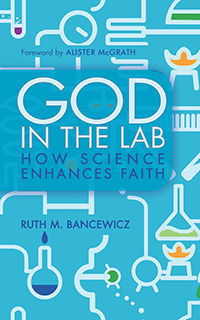Book Review: God in the Lab
God in the Lab:
How Science Enhances Faith
by Ruth Bancewicz
Review by Dianne Van Rooyen
Dr. Ruth Bancewicz is a Senior Research Associate at the Faraday Institute for Science and Religion at Cambridge University. Her purpose in writing God in the Lab: How Science Enhances Faith “is not merely to show that science is consistent with faith, but that science enhances faith. This richly documented book weaves together Dr. Bancewicz’s own experience as a scientist with the stories of other scientists, who have found that their faith was deepened by their research and reflections. These personal narratives convey the rich potential for dialogue and interaction between science and faith far more effectively that reams of reasoned argument.” (From the foreword by Alister McGrath, Oxford University.)
Bancewicz purports that the real work of science is done in the lab, engaging in the process of doing science, not simply reading about science. In the lab the nature of science is revealed through collecting raw data and forming hypotheses that are in turn discarded, remade, and tested by others until they surface as a theory which later changes as new data is revealed.
She begins by explaining how hands-on science works, giving fly-on-the-wall observations of life inside science laboratories. She explains her own commitment to Christ and why she sees faith and (natural) science complementing one another.
Bancewicz explores the vital role of creativity and imagination in the practice of both science and Christianity and explains how the practices required to do science enhances our faith in God. First, scientists need to be creative: they build on the work already done by others, or dare to think and do something that has never been done before. This is just what we see God doing in the beginning of Genesis. Second, a scientist’s work in the lab requires imagination: they envision models and describe concepts in order to form mental pictures of the world. The work of the imagination assumes there is truth to be found.
The book explains how the natural outworking of this process of creativity and imagination leads to beauty, wonder, and awe. There is great beauty found in the intricate things in nature. In the lab, for example, a one dimensional textbook diagram of a cell comes alive “in exquisite detail using powerful microscopes” allowing students to share in the wonder. “Creation itself is calling out to us, saying something about its Creator.” Wonder leads to questioning where this beauty comes from, and awe at the vastness of the world or at the incredibly robust DNA replication, causes us to pause, sit back with eyes wide, and leads us to worship. She records experiences of awe that have lead some scientists beyond their work to contemplate and worship God
Inquiry-based learning that involves students in the process of doing science is not only good pedagogy, it can strengthen their faith, “bringing a deeper sense of worship of the God who created everything.” While not specifically written for teachers, God in the Lab gives excellent suggestions on how to cultivate habits to use in classrooms, and provides a rich resource of scientists who serve as models.
Instead of presenting arguments for the existence of God per se, she asks, “If the God of the Bible existed, what would you expect to see in the world? Does viewing the world through the lens of faith make it look more coherent?” Insights gleaned from “the laboratory and the library” open dialogue so people can learn from each other and delve into the deeper questions raised by science and faith.

